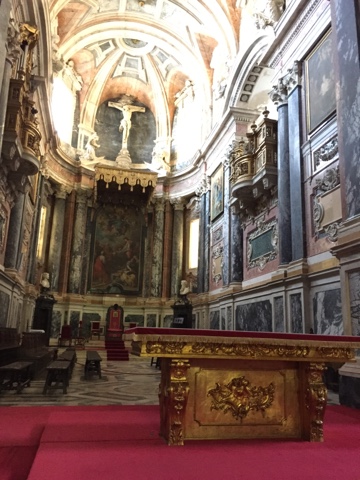We left the cosmopolitan city of Lisbon today and journeyed to the small town of Evora, which is southeast of the capital and near Spain. It is in an arid plain in the province of Alentejo. Our bus ride took less than 2 hours.
The city has been settled since 2 B.C. when the Romans conquered the Lusitanians and stayed until the fourth century AD. Evidence of the Romans' time here still exists with the ruins of a Roman temple on the highest hill over looking the city and Roman baths unearthed in the basement of the town hall.
Later during the 15th and 16th century, it was the home of Portuguese kings and their entourage. It was at this time that an aqueduct was built to supply the arid city with water and remains of this can be seen around town.
The old town is contained within a medieval wall. It was declared a World Heritage Center in 1986 and has strict preservation rules. Many of the buildings have yellow trim that is believed to repel evil spirits.
And many of the cobblestone streets are barely wide enough for one car - much less another car or pedestrian.
We were met by our guide, Maria, who took us to the important sights. Foremost was Giraldo Plaza flanked by arcades with shops and restaurants and the Church of San Antonio.
Then to the Roman Temple where we also saw the Pousada dos Loios, once a 15th century monastery but now a fancy hotel (to the right).
Next was the Cathedral. It sits on top of a mosque which was actually built on an early church. Known as Santa Maria de Evora, it was built in the 12th century and is a transitional mix of Romanesque and Gothic. More to see but I decided to come back later for the tower tour.
Then to the Church of St. Francis and the Chapel of Bones. Dedicated to the humble saint, the church has a single nave lined by chapels. However in the 18th century wealthy families decided to buy these chapels and decorate them, creating a gold-leaf hodgepodge.
This is contrasted with the adjoining bone chapel (Capela dos Ossos). Some monks in the early 1600s became concerned about society's values and wanted to create a space where people could meditate on the transience of material things. Bones, including skulls, line the walls.
They were unearthed from various Evora churchyards.
Following this we had free time so I walked around a city park and then looked in some shops. Many of the stores had purses and other accessories made of cork. (More about that tomorrow.)
I went back to the Cathedral and decided to go up to the rooftop terrace. Little did I know what I was in for. The final 20 or so stairs to the top are spiral and tiny. Someone was coming down and we literally had to hug each other so that neither of us let go of the narrow steel rail. But the view was worth it. I got a close up look at the cathedral's lantern tower and the baroque flaming vases around it. The surrounding countryside was expansive.Coming back down the stairs, I came down backwards and prayed I met no one. I also checked out the cloister, which was lovely but filled with student field trips.



















No comments:
Post a Comment